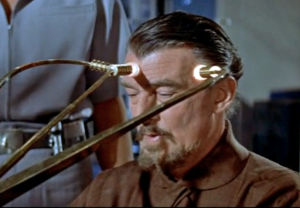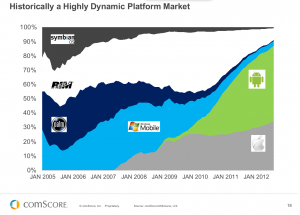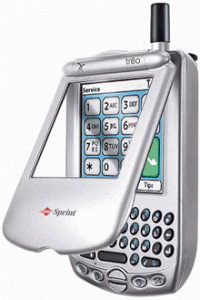
Walter Pidgeon tries on the Krell Brain Booster in the 1956 Sci-Fi classic “Forbidden Planet.” Though it increased his already considerable intelligence to astounding levels, it also unleashed the dark side in his subconscious. Let’s hope smartphones use their power for good, rather than evil.(photo: MGM)
IBM brought a touchscreen phone named Simon with more than phone functions to the market in 1994. Nokia produced the Nokia 9000, a clam-shell phone/PDA with a keyboard in 1996, which was, at the time, their best selling phone. But it wasn’t until the 1997 that Nokia called the GS 88 “Penelope,” the successor to the 9000 a “smartphone,” coining the term that would describe all phones with computing capabilities built in from then on. That’s the official story, and it’s factual, but I think it’s off the mark.
The Way of The Dinosaurs
The GS 88 was smart, certainly, and a phone, arguably, but its clamshell with a keyboard format showed its mini-computer heritage, coming out of “palmtop” computers like the HP100 LX and the Psion MXs, which were trying hard to be laptop computers you could fit in a pocket, though it had to be a big pocket. They were an attempt to get around the size and weight of early laptops in a time when the concept of something like an ultra-book was still in the realm of science fiction. While palmtop computers were a good idea, they never really caught on, and represent a branch of computer evolution that went the way of the dinosaurs. Like many techie folks, I’m fond of dinosaurs, and I was very fond of my palmtop computer, and sorry to see it die off. But it did, and we (mostly) moved on.
A Phone Fits in Your Palm
The first real phone to get its mind-boosted to Krell-like levels was the PDQ 800/1600 made by Qualcomm, using the Palm Pilot platform and introduced in late 1999. While it got a lot of buzz, it was clunky, you had to pay for data and voice separately, and there was no QWERTY keyboard, meaning that you had to either use a stylus and Palm’s “Graffiti” screen language or hunt and peck on the phone’s buttons. Palm, or Handspring, which they acquired, did come out with a much more advanced smartphone in 2002 with the Treo 180, which offered a very decent keyboard, touchscreen, and a form factor that Captain Kirk could love. I was at CES in Las Vegas for the release, and the Treo was far and away the hit of the show.
RIM/Blackberry added phone service to its already connected devices in 2004, with the BlackBerry 6710, which featured (IMHO) one of the best small keyboards ever made, a hallmark of RIM’s devices. The 6710 and its descendents were the gold standard for business for the remainder of the decade, though they are now slipping into oblivion. Solidly wearing their business glasses, they were never close to cool, and forever niche marketed, though a pretty powerful niche.
Steve Jobs. iPhone. Any Questions?
in 2007, and neither for the first or last time, Steve Jobs and Apple broke the geek barrier with the iPhone, a product so cool that the fact that it was really useful was unable to keep it out of the hands of consumers. Like all Apple products, it put a natural style of interaction first and all the geek speak last and as you know, it caused a revolution. But while the iPhone moved the product into a wider audience, it was still an elite brand and appealed to an elite set of users. Apple’s brand identity was, and is, so strong, that there were groups of otherwise early adopters that were put off by the brand. It still wasn’t the phone for many. In fact, smartphone sales didn’t take off dramatically for another year and a half.
And then Something Interesting Happened
If you look at the global sales of smartphones, you’ll find that in late 2008, what had been a fairly flat market took off in a big way. That’s a year and a half after the first iPhone, and six years after Palm added cellular capability to a PDA and introduced the Treo. Despite the iPhone’s introduction and tremendous popularity, the overall market had failed to explode. So what triggered the rise?
On the one hand, the iPhone got an upgrade in July of 2008, and its official European release in November. Probably the most important change to the iPhone wasn’t its 3G connectivity however, but the pricing model, which then changed to follow the mobile phone industry’s standard, heavily offsetting the price in return for a contract commitment. With that change, the iPhone went from begin an exotic gizmo to an affordable gadget. And of course, it was always cool. But the numbers show that it wasn’t the whole story. In fact, although Apple had broken the barrier for consumer adoption, they weren’t the ones who were going to gain the most from it.
It wasn’t Apple alone that made smartphones take off in late 08. In October, HTC introduced the first Android OS phone, the HTC Dream, sold by T-Mobile as the G1. Though it would take the next four years for Android devices to match Apple’s market share, it was no longer a one horse race, and the world knew it.
Granted, there had been other smartphone OSs around. The Symbian OS, developed by PDA maker Psion and released in 2002, stayed the most popular smartphone OS in Europe for the better part of the decade, until Nokia announced that it was switching to Microsoft’s Windows Phone platform. But until Android’s release, nothing significantly challenged Apple’s mobile dominance.
Android, based on the Open Source Linux OS, is itself Open Source, though much of the software that comes with it is proprietary software, and since it runs on non-proprietary hardware, its entry marked the beginning of a development explosion in both applications and devices that Apple’s close licensing does not.

Apple and Android together eroded the market share of RIM and Sybmian, becoming the dominant smartphone players by the end o the decade. (source: DailyTech.com)
A Rising Tide…
By the end of the decade, Apple and Android had completely reversed the market share for smartphone operating systems. Symbian was a marginal player soon to be replaced by Microsoft in their acquisition of Nokia, and RIM was hanging onto a shrinking niche in government and business. In 2007 only about 120 million smartphones where sold worldwide, but by the end of 2013 that number had risen to nearly 500 million units. In 2012 Ericsson forecast that smartphone subscriptions worldwide will be 1.1 billion by the end of 2012 growing to 3.3 billion in 2018. Now, granted that the global population will probably be about 8 billion by then, it’s going to have to so some time until everyone on Earth has a smartphone.
Maybe even a decade.
Links / References
- IMDB: MGM, 1956, Forbidden Planet: http://www.imdb.com/title/tt0049223/synopsis
- Wikipedia: HP LX Series: http://en.wikipedia.org/wiki/HP_200LX
- Wikipedia, Psion Series 5: http://en.wikipedia.org/wiki/Psion_Series_5
- Wikipedia: http://en.wikipedia.org/wiki/History_of_the_iPhone
- Wikipedia: http://en.wikipedia.org/wiki/HTC_Dream
- DailyTech.com: The History of Normandy: http://www.dailytech.com/The+History+of+Normandy+How+Nokia+Plotted+a+LowEnd+Android+Line/article33909.htm
- Ericsson: Ericsson Mobility Report: http://www.ericsson.com/ericsson-mobility-report


